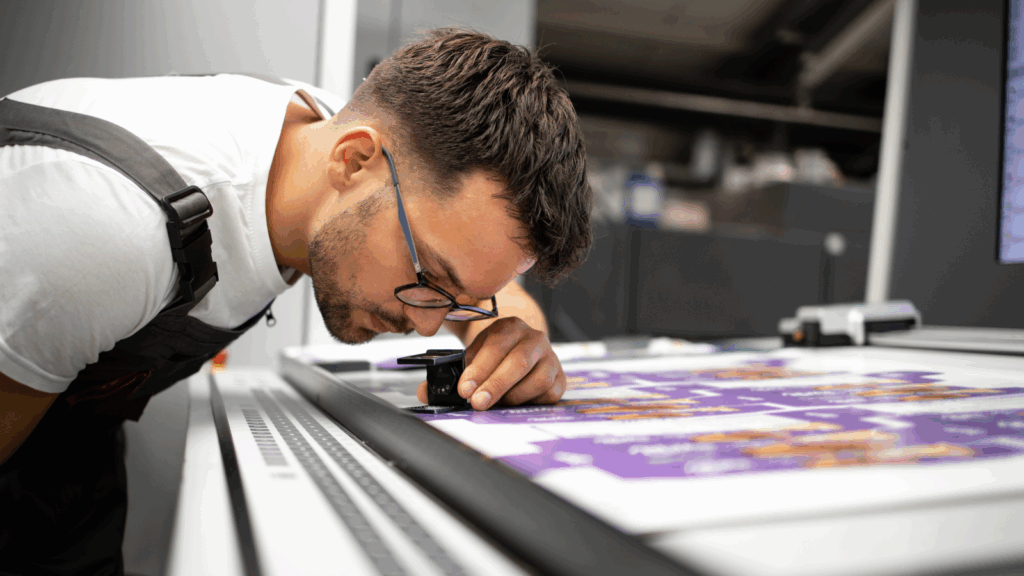Start your custom printing business today!
If you’ve got original artwork tucked away, it’s time to bring it to the world – and make money doing it.
This guide walks you through how to make prints of your art that actually sell. Whether you’re painting, sketching, or going digital, we’ll show you how to transform your work into print-on-demand products people want to buy.
From choosing the right print types to prepping your files, here’s how to sell prints of your art in 2026.
This post may contain affiliate links, which means we may earn a commission if you make a purchase through those links. This comes at no additional cost to you.
Key takeaways
- Choose the right print format – whether fine art prints, canvas, or metal prints – based on your artwork and target audience.
- To offer high-quality prints of your art, use a high-resolution photograph or a professional-grade scan. Always opt for CMYK color mode for color accuracy.
- Select the best fine art paper or archival paper to achieve the texture, depth, and durability your art deserves.
- Print on Demand is the best way for artists to avoid upfront costs and start selling art prints online with no inventory management.
- Building a successful art business means understanding your target buyers, offering stunning custom products, and marketing your work across platforms to reach a wider audience.
Print vs original: What’s the difference?

Before you dive into selling prints, it’s important to understand how they differ from original artwork – and why that difference matters to buyers.
Originals
This is a one-of-a-kind piece created by the artist. Owning an original often carries special significance and emotional value because it’s the direct result of the artist’s creative process, which is why they’re also more expensive.
Collectors and art enthusiasts treasure original art pieces for their authenticity, often viewing them as investments that will become more valuable over time.
Prints
Art prints are reproductions of original artwork created using different printing techniques on materials like canvas and fine art paper. These prints let artists sell the same work multiple times at an affordable price.
A high-quality print captures the color and detail of the original, making art accessible without the high cost of an original piece. If you want to maintain a sense of exclusivity, sell limited-edition prints.
How to make and sell art prints in 6 steps
Create professional-grade prints of your original work to expand your art business and make more money. Follow these six steps to digitize, produce, and sell prints of your art online.
1. Go digital

First, you need to convert your masterpieces to a digital format.
Scan
This method is ideal for capturing your artwork’s fine details and colors. Use a high-quality scanner, clean up any stray marks, and save your scanned image file with a minimum resolution of 300 PPI (pixels per inch).
Photograph
No scanner? High-quality photographs can be just as good.
Take a photo with a camera or smartphone and use a tripod for stability. Find good lighting to avoid shadows and reflections that might distort colors and details.
2. Prepare your file for printing

Your files will need a bit of adjusting before they’re print-perfect.
Photo editing
Use software like Adobe Photoshop to adjust the colors and contrast to match your original artwork. For the best printing results, put your file in CMYK instead of RGB.
High resolution
The print resolution should be at least 300 PPI to make the result as clear and detailed as the original. Larger prints may need a higher PPI, so consult your print provider before ordering big art prints. Save your files in PNG, SVG, or JPEG format.
3. Choose how to make your prints
There are a few ways to turn your original artwork into stunning prints. The best choice depends on how much time, money, and effort you can put in.
Making your own prints at home
This gives you complete control over printing, materials, and quality. However, it means investing in a high-quality printer and materials, which are costly and will take up space in your home.
Using Print on Demand

Print-on-demand services like Printify make it easy to sell art prints online without any upfront investment.
Our Catalog has tons of options for printing artwork, from posters and canvases to acrylic and ceramic. Choose the material, use our Product Creator to upload your artwork, set a price, write an item description, and list it on your online store.
When a customer purchases your prints, our worldwide network of Print Providers will print, package, and ship your artwork to them. This frees you from the hassle of order fulfillment – so you can keep the creativity flowing.
4. Decide what materials to print on: Canvas prints, metal prints, digital prints, or other
The material you select can make or break your art prints. The right base will help preserve details, elevate the piece, and meet your potential buyers’ expectations.
Here’s how different materials compare based on aesthetics, durability, and cost.
Canvas
Want texture and depth? Canvas mimics the feel of original paintings, making them perfect for home decor or collectors. Its matte finish reduces glare and enhances brushstroke details.
- Aesthetics – Classic, elevated, timeless
- Durability – Long-lasting if kept indoors and stretched properly
- Cost vs quality – Mid-range price, premium feel
- Best for – Paintings and gallery-style displays that mimic originals
Posters
Posters are budget-friendly and versatile. Great for appealing to a broader audience, they come in various print sizes and materials, like photo or matte paper. Choose acid-free paper to prevent yellowing over time.
- Aesthetics – Clean and modern, especially in minimalist frames
- Durability – Moderate but will show signs of wear over time if not framed
- Cost vs quality – Very affordable and scalable for bulk orders
- Best for – High-volume sales, trendy designs, budget-friendly art for students
Framed prints
Framed prints deliver a polished, ready-to-display product – ideal for gifts, collectors, or art shows. They’re a level up from posters and elevate perceived value.
- Aesthetics – Professional, gallery-ready
- Durability – High if protected by glass or acrylic
- Cost vs quality – More expensive than posters, but ready-to-hang products sell well
- Best for – Premium buyers, gifting, in-person sales
Fine art prints
For collectors and galleries, prints made with fine art paper or archival paper offer the best in tone, texture, and longevity. Matte paper provides a soft, non-reflective finish that’s ideal for detailed pieces.
- Aesthetics – Elegant, detail-rich, true to the original artwork
- Durability – Excellent, especially with archival materials
- Cost vs quality – Higher, but justified for serious buyers
- Best for – Limited editions, high-end art prints, gallery displays
Metal prints
These are great for exploring how to print digital art to sell. Metal prints are vivid, sharp, and built to last. Perfect for high-quality photographs, photography-based digital work, or bold contemporary pieces.
- Aesthetics – Glossy, vibrant, futuristic
- Durability – Excellent as it’s scratch-resistant and waterproof
- Cost vs quality – Premium, but stands out
- Best for – Modern interiors, outdoor use, bold color compositions
Acrylic prints
Acrylic prints feature your image behind clear acrylic glass, delivering maximum depth, detail, and gloss. They’re a great choice for digital prints relying on high clarity and contrast.
- Aesthetics – High-gloss, sleek, upscale
- Durability – UV-protected, moisture-resistant, prone to scratches
- Cost vs quality – High-end, luxury-tier option
- Best for – Photographic prints, high-end decor, colorful designs
5. Get samples
Before you start selling, always order samples of your own prints. This is where many artists either elevate their brand – or miss the mark. Product samples let you evaluate the final appearance, material quality, and print accuracy before your customers see the product.
Check for:
- Color accuracy – Does the print match your original piece?
- Sharpness and detail – Especially on high-quality photographs
- Print finish – Does it reflect your intended aesthetic appeal?
- Material performance – Test texture, weight, and durability
Use this step to fine-tune your settings. You might need to adjust your file, change the resolution, or re-export using a photo editing program in CMYK color mode for better results.
Once you’re satisfied, photograph your samples under natural light to capture their true quality. These images are essential for building trust and credibility in your online store or portfolio.
6. Start selling your art online

Ready to earn from your art? Here are a few ways on how to make art prints available online to sell.
Online marketplaces – Easy access to millions of shoppers
Many artists started selling prints on marketplaces. They give you instant exposure without needing to build a website from scratch. The tradeoff? Payment processing fees and less customization.
Top picks:
- Etsy – The go-to for handmade and custom art
- eBay – Great for collectors and one-off pieces
- Amazon – Massive reach, high-traffic platform
- TikTok Shop – Ideal for viral products and visual storytelling
eCommerce platforms – More control and brand consistency
Create a fully branded store with custom domains, layouts, and apps. They’re perfect for artists focused on scaling and owning the full appearance of their brand.
Popular options:
- Shopify – Best for scaling and large third-party app selection
- Wix – User-friendly and visually flexible
- BigCommerce – Solid choice for high-volume sellers
- Squarespace – Sleek design, good for portfolios
Pop-Up Store – Sell without a full website

Wondering how to sell art prints with no subscription or platform fees? Open a Printify Pop-Up Store – a completely free, no-code storefront you can launch in minutes.
It’s ideal if you’re testing custom products, launching a single collection, or selling at art shows or events. Plus, it’s fully integrated with our print-on-demand services, with no extra steps involved.
Just add your art, set a price, and share your link to start selling.
Your own website – Full creative control
If you’re tech-savvy or working with a developer, building your own online store from scratch offers total freedom over design, user flow, and data. It’s the best option for long-term scaling, but requires extra effort.
Want us to still handle fulfillment? Use the Printify API to connect your custom-built site.
Advantages of selling art prints
Selling prints of your artwork helps you grow your income and share your unique vision with art lovers everywhere. Let’s look at some of the biggest advantages of selling art prints online.
Growth
Creating prints is an excellent way to grow your business. You can sell multiple copies of the same piece without the time and effort required to create new originals.
Steady income
No more waiting until your latest piece is complete to make some money. Selling prints provides a consistent income stream since you can sell reproductions of your popular artworks again and again.
Low risk
If you sell prints with an on-demand printing company like Printify, you won’t pay for production until a customer orders. This reduces your upfront investment and financial risk.
Brand exposure
Offering prints improves your brand visibility. With lower price points than originals, more people can own your work – expanding your reach and helping establish your name in the art market.
Various sizes and formats
Prints come in many shapes and styles, meaning there’s something for everyone. Printify’s Catalog offers tons of options to suit every kind of art and buyer.
Tips for starting your art business online

Whether you’re using Print on Demand or managing your own inventory and learning how to make canvas prints to sell, here are some tips for building a successful art store that will profit for years.
Personalize your art store
Make your virtual storefront stand out. Choose a catchy store name that reflects your style, then customize your shop to match your artistic vision. Add a compelling bio that tells your story and lets buyers connect with the artist behind the work.
Stock your store with care
Use high-resolution photographs to show off your work in detail. Write product descriptions that highlight what makes each piece unique – mention the print size, paper type, and other relevant info. This builds trust and sets expectations, helping buyers feel confident in their purchases.
Set smart prices
Price your work for both profit and reach. Calculate your costs and desired margins, then research your competitors. Need help? Check out our guide on how to price your products to find that sweet spot.
Expand your product range
Don’t limit yourself to canvas or fine art paper prints. Expand into other formats to appeal to a broader audience and increase sales:
- Postcards – Low-cost, collectible, and great for seasonal sales
- Journals and notebooks – Practical, purposeful, and personal
- Calendars – Showcase a full collection in a single product
- Mugs – Useful, giftable, and eye-catching
- Phone cases – Great for abstract or photo-based art
These POD products help you maximize sales and profitability without the need to manage inventory.
Promote your art store

Social media
Instagram, Pinterest, TikTok, and YouTube are goldmines for visual storytelling. Share your beautiful prints, behind-the-scenes shots, or even time-lapse videos of your process.
Engage potential customers by responding to comments, using hashtags, and going live to build a community. Consider running paid ads to get prints of your art in front of more people.
Email marketing
Use pop-ups or opt-in forms to build your email list. Discounts and exclusive content are great incentives. Send regular updates featuring new collections, art stories, or promo codes. Many other artists have built strong audiences and gained repeat customers this way.
Connect with the art world
Join online art forums on Reddit, DeviantArt, or Facebook. Participate in art shows, fairs, and exhibitions to share your journey, get feedback, and build relationships. Another idea is to team up with local galleries or businesses to exhibit or offer high-quality prints up for sale.
Content strategy
Create a content calendar and plan what to post, when to publish, and which formats to use (reels, carousels, videos) to get the most engagement. Tie your promotions to holiday seasons, product launches, or milestones.
Tweak for success
With Print on Demand, experimenting with your store is simple – no stock, no waste. Add new designs, test formats like original paintings reproduced on metal sheets or posters, and adjust your pricing based on what actually sells.
Use your store’s analytics to spot trends, remove underperformers, and highlight customer favorites. It’s not about getting it perfect on day one – it’s about refining as you go.
Make it personal
Send thank-you notes for supporting your art and ask customers to share photos of their new pieces.
Want to take it a step further? Offer personalization or commissions. These gestures elevate your art from product to personal experience – and that’s what keeps people coming back.
Creating art prints FAQs
To make prints of artwork, start by digitizing it. You can:
- Scan it – Use a scanner at 300 PPI or higher for crisp, high-res photographs.
- Photograph it – If the piece is too large to scan, shoot it in natural light using a DSLR or smartphone with manual settings.
Once digitized, upload the file to a print-on-demand platform like Printify. Choose your print medium, like canvas or posters, and order a sample or start selling.
If your art is already digital, use photo editing software to remove imperfections, adjust the colors, and save as a high-resolution file. Then, choose a printing company, like Printify, and follow our steps in this article on how to make prints of digital art.
Many print companies, like Printify, offer tons of ready-to-print canvas products. Simply choose a canvas style and size, upload your digital artwork to our Product Creator, and let our Print Providers handle the rest.
The best printing method for your art print depends on your budget, desired aesthetic, and the type of artwork.
Here are the most popular printmaking techniques:
- Giclée
- printing – Also known as inkjet printing, this is a favorite among artists and galleries for its exceptional color accuracy and quality.
- Screen printing – Involves multiple steps and can be messy but offers vibrant colors and a unique textured feel.
If you’re wondering how to make prints of paintings, start by digitizing your artwork using a high-resolution scanner or camera, then upload the file to a print-on-demand platform.
This will be your master copy for producing stunning prints on different materials like canvas, fine art paper, or other POD products. It’s the perfect solution if you’ve just started selling prints or plan to showcase your work at art galleries and shows.
Sell prints with Print on Demand
Whether you’re a seasoned artist or just getting started selling prints, turning your work into high-quality products has never been easier. With Print on Demand, there’s no need for upfront inventory or equipment – just upload your art and start selling to your audience.
From canvas to metal, fine art paper, and more, Printify helps you create stunning, lasting pieces that reflect your vision. Let your creativity do the talking and sell your art anywhere, anytime – while we handle the logistics.


















































